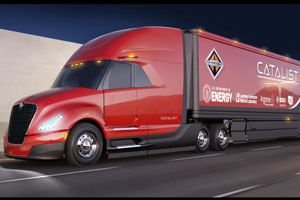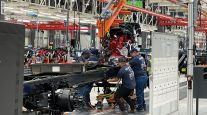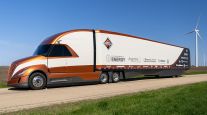Navistar's SuperTruck Concept, CatalIST, Demonstrates Engine and Fuel Efficiency

Known as CatalIST, with the last three letters standing for International SuperTruck, the experimental Class 8 hit 50.3% for brake thermal efficiency, up from 42% in the 2009 baseline. BTE measures actual work done by an engine as a percentage of the potential for work.
CatalIST is a modified ProStar tractor hooked to an altered 53-foot Wabash National Corp. trailer. Freight efficiency, measured in ton-miles transported per gallon of fuel used, more than doubled, gaining 104%, Navistar said in a Sept. 28 statement.
“CatalIST’s significant improvements in freight efficiency, achieved with the support of DOE’s SuperTruck program, demonstrate tremendous potential for reduction in the trucking industry’s consumption of energy,” said Mark Stasell, Navistar vice president of product development. He said some of the new systems, such as predictive cruise control, are already used on current production vehicles.
SuperTruck provided four OEMs with grant money for research and development that had to be matched equally by the manufacturer.
Volvo Trucks North America was the most recent OEM to demonstrate a SuperTruck, rolling out its version Sept. 13 in Washington, D.C., at DOE headquarters. Daimler Trucks North America and a combination of Cummins Inc. and Peterbilt Motors Co. have also demonstrated SuperTruck vehicles.
In August, DOE announced details on SuperTruck II, which will feature the same four participants.
Navistar used one of its N13 engines to power CatalIST. The N13 is based on a MAN SE European truck engine.
Navistar said CatalIST’s miles per gallon rating was 13, but declined to release a 2009 baseline level.
Technologies used by Navistar, parent of International trucks, include: intelligent controls and high-efficiency combustion for the engine; reducing aerodynamic drag by replacing exterior, side-view mirrors with cameras; greater use of light-emitting diodes, or LEDs; a new cab shape that incorporates carbon-fiber panels; and a suspension made of lightweight alloys.




